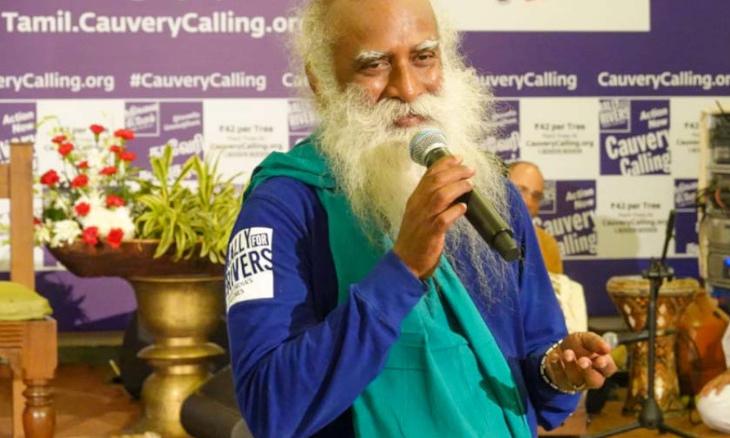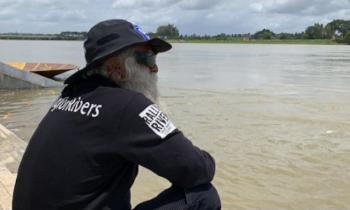Cauvery Calling - A complete solution to India's Water Crisis
Sadhguru explains how Cauvery Calling is a complete plan that addresses water crisis holistically by benefiting the farmers and revitalizing the river.

Sadhguru: The most precious thing we can leave for the next generation is not business or money or gold. The most important thing we can give to the next generation is a land that is rich and rivers that flow.
For both these aspects, trees are very significant. If soil has to be rich, there are only two sources: the leaves from trees, and animal waste. The trees have gone a long time ago and animals are travelling abroad. So what material are we going to enrich the soil with? Without trees and animals, there is really no solution.
Similarly with water, the misunderstanding in most people’s minds is that a river is a source of water. No, in a tropical nation, a river, pond or lake is not a source of water, it is a destination for water. There is only one source of water, which is the monsoon rain.
Agroforestry to Revive Water and Soil
Putting animals and trees back on the land is the most important thing to do. This is something we have been implementing at a certain scale over the last decade. We have supported 69,760 farmers to shift from conventional crops to agroforestry.
Agroforestry is the practice where trees are planted alongside conventional crops. This not only improves the soil and water situation, there is also a huge improvement in the farmer’s economic situation. Their income can increase three to eight times in five to seven years.
We want to bring agroforestry to the entire Cauvery basin, which is about 83,000 square kilometers. If one third of the land goes under tree shade, Cauvery will definitely flow because the data says that for every tree that is planted, it will retain around 3800 liters of water a year in the soil.
What Trees to Plant?
There is a methodology to agroforestry which allows for different species of trees to be harvested at three-and-a-half years, at seven years, at twelve years and at fifteen years. In our agroforestry models, we have left out those species that cannot be economically harnessed. We have also been selective about choosing native species that grow in this region.
We have taken this care because for example, in Wayanad, Kerala, many farmers planted eucalyptus trees. Eucalyptus causes enormous damage to the land. So we have made sure that only those species that will go well with the land are part of our recommendations.
Agroforestry is not as good as a forest and it is never going to be. You cannot tell the farmer to make his land into a forest because it is his livelihood. But agroforestry is better for the farmer than ploughing the land every three months, which is what he has to do if he goes for conventional crops.
Agroforestry is a very complex way of growing different species, so that they benefit from each other. If individual farmers go for agroforestry, if their lands are over ten acres, we can do it in a much more complex way. If the land is one to three acres, too much complexity is not possible. You have to do it a little more simplistically, which is not the best way to go about it. But if you look for the ideal, you will never do anything. You have to do it the way it is going to work right now. Otherwise nothing will happen, we will just be talking about it forever.
The Plan
Right now, we are supporting farmers to plant 242 crore trees in the Cauvery basin. Farmers are going to take this up as an economic activity. The saplings are going to come from donations made by people – this is where we need people’s support.
Apart from that, the government has to incentivize a farmer to move from the regular three-month, four-month cropping to tree-based cropping, which is a long term investment. This is an insurance to ensure that farmers do not kill themselves or get into a debt trap.
Eighty-three percent of Tamil Nadu farmers are in debt. In Karnataka, seventy-seven percent of them are in debt. Most of them have no means to pay back the loans that they have taken. That is the reason everyone keeps talking about loan waivers.
In fact, loan waivers will work against us because if a loan is waived, the next time a farmer needs a loan, no bank is going to give him a loan. The whole movement of nationalizing banks that took place in the 1970s in India made bank finance available to the rural population. That whole revolution is in the process of being destroyed right now. Once again, we are pushing the rural population into the hands of local money lenders who will charge up to seventy percent interest per year.
Unless we make farming a very lucrative process, we are threatening the future of this nation in many ways. If you conduct a survey right now and ask farmers how many of them want their children to go into farming, believe me, only two to five percent of them will want this for their children.
This means in the next twenty to twenty-five years, when this generation passes, we would have lost all ability to grow food. With 1.3 billion people on our hands, if we lose the ability to grow food, you can imagine the disaster we will cause in this country. That is why Rally for Rivers and now Cauvery Calling. I want all of you to be part of it in some way, in whichever way you can.












